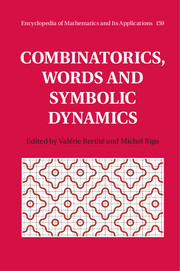Book contents
- Frontmatter
- Contents
- List of contributors
- Preface
- Acknowledgments
- 1 Preliminaries
- 2 Expansions in non-integer bases
- 3 Medieties, end-first algorithms, and the case of Rosen continued fractions
- 4 Repetitions in words
- 5 Text redundancies
- 6 Similarity relations on words
- 7 Synchronised automata
- 8 Cellular automata, tilings and (un)computability
- 9 Multidimensional shifts of finite type and sofic shifts
- 10 Linearly recursive sequences and Dynkin diagrams
- 11 Pseudo-randomness of a random Kronecker sequence. An instance of dynamical analysis
- Bibliography
- Notation index
- General index
7 - Synchronised automata
Published online by Cambridge University Press: 05 January 2016
- Frontmatter
- Contents
- List of contributors
- Preface
- Acknowledgments
- 1 Preliminaries
- 2 Expansions in non-integer bases
- 3 Medieties, end-first algorithms, and the case of Rosen continued fractions
- 4 Repetitions in words
- 5 Text redundancies
- 6 Similarity relations on words
- 7 Synchronised automata
- 8 Cellular automata, tilings and (un)computability
- 9 Multidimensional shifts of finite type and sofic shifts
- 10 Linearly recursive sequences and Dynkin diagrams
- 11 Pseudo-randomness of a random Kronecker sequence. An instance of dynamical analysis
- Bibliography
- Notation index
- General index
Summary
Introduction
The notions of synchronising word and synchronised automaton are simple to define and occur in many applications of automata. A synchronising word maps every state of an automaton to the same state. It is remarkable that this simple notion is linked with difficult combinatorial problems.
Some of them, like the Černý Conjecture, have been open for a long time. This conjecture asserts that a synchronised deterministic automaton with n states has a synchronising word of length at most (n−1)2.
Another longstanding open problem, the Road Colouring Problem, was solved by Trahtman in 2009. The problem asks whether any complete deterministic automaton has the same graph as a synchronised automaton. The choice of the labels of the edges defines a colouring to which the term Road Colouring Problem refers.
A reason to explain the difficulty of these questions may be the fact that there is no simple description of the class of automata that are not synchronised. It is relatively simple to verify whether an automaton is synchronised since it can be checked with a polynomial algorithm. On the contrary, it was proved by Eppstein (1990) that finding a synchronising word of minimal length is NP-hard.
Recently, some results have been obtained on the synchronising properties of random automata showing that a random automaton is synchronised with high probability (see Berlinkov (2013), Nicaud (2014)).
In this chapter, we present a survey of results concerning synchronised automata. We first define the notions of synchronising words and synchronised automata for deterministic automata. We extend these notions to the more general class of unambiguous automata.
In Section 7.3, we present Černý's conjecture and discuss several particular cases where a positive answer is known. This includes the important case of aperiodic automata solved by Trahtman (2007).We also describe the case of circular automata Dubuc (1998), the case of one-cluster automata introduced by Béal et al. (2011), and more generally the strongly transitive automata of Carpi and D'Alessandro (2013).
In Section 7.4, we present the Road Colouring Theorem (i.e., the solution of Trahtman to the Road Colouring Problem). We present here Trahtman's cubic-time algorithm. A quadratic-time algorithmis given in Béal and Perrin (2014).
- Type
- Chapter
- Information
- Combinatorics, Words and Symbolic Dynamics , pp. 213 - 240Publisher: Cambridge University PressPrint publication year: 2016

